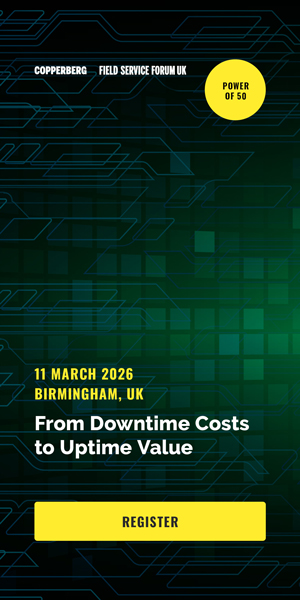At the recent AfterMarket conference in Amsterdam Field Service News Editor, Kris Oldland hosted a panel debate with three speakers key to servitization; Professor Tim Baines, Aston University a leading proponent of the movement, Brendan Viggers, Product and Sales Support for IFS Aerospace & Defence division who has worked closely with a number of companies such as Emirates on moving towards a servitization model and Koen D’Haeyer, Global Manager Service Development & Technical Services Lely who had been through the journey himself with Dutch Farm Technology company.
In the first part of this feature we looked at whether servitization was limited to just large size companies and how to manage the change involved in moving to such a radical new approach. Here in the final part of this feature the debate continues….
Kris Oldland: There is a point there that you touch on briefly about not just getting the buy in from the internal teams but also from the customer. Data can play a significant part in servitization and that presents a challenge in it’s own right, as data is very precious currently. How can we overcome that and encourage our customers to let us access their data?
Koen Dyaeyer: To start I’ll mention one thing, there is an aspect on this benchmarking data with your customers which is of course, that you are obliged to do this anonymously that is clear. You can tell the a customer ‘look this is your data this is the rest of the market and this is the variation’ but you cannot be open to all extents.
But the value is not in knowing exactly who is doing what, the value is in comparing yourself with others and knowing what to learn, and how to then improve.
[quote float=”left”] I would say twenty to thirty percent may adopt really quickly, really embrace it and are immeditely fond of the concept, another twenty to thirty percent will be lagging – it is not in their mindset and then the part in the middle is where you have to push[/quote] On the other hand it is also true that you have to select your targets when your developing these value propositions. This approach may not fit every type of customer immediately. I would say twenty to thirty percent may adopt really quickly, really embrace it and are immeditely fond of the concept, another twenty to thirty percent will be lagging – it is not in their mindset and then the part in the middle is where you have to push. And when you have pushed and achieved the 80% mark then you can approach the laggards. That is more or less how we approached it so we didn’t lose to much time and energy in developing it.
Brendan Viggers: Certainly in the defence market the classic contracting model is performance based logistics where the OEM is providing a platform and then the through life support of the platform as well, so all the servicing that goes with it and they will then offer a SLA or guarantee the fleet availability for 80% of that time.
What we are finding is there is a need for partnership between the OEM and the customer. Because the OEM needs to know how the customer is driving that vehicle. If he is taking that tank and forcing it across a plain over the bounds of normal operational use then it’s going to cost that OEM more to service it. So can be a win-win but if you want that platform you need to be prepared to operate within acceptable bounds.
Koen Dyaeyer: To add to Brendan’s point there I would add that in our case we are looking for the win-win-win because we are in between but if we focusses on the win-win-wins we can really drive forward.
Tim Baines: This debate about ownership of data has been going on for over 10 years. To my mind its the use of the data that is important. I’ve seen it in Xerox’s case where they will turn around and say OK the contract price is this for an advanced services contract on print management but if you let us share that data and use that data it’ll come down to this.
Audience Question: What would you say are your most important KPIs to actually monitor and drive your service business today?
Koen Dyaeyer: The most important group of KPIs are the service profitability KPI’s we have data on overall revenues and data on cost indicators. We cannot always be exact with th eservice cost indicators to the penny but we know what it is likely to be. So the service profitability is a major KPI.
[quote float=”right”]The first question we ask in every technical assessment is what type of customer do you think this is and also is he satisfied? So we link that data to understand the relationship of data to customer satisfaction.[/quote] Then there is customer satisfaction. The first question we ask in every technical assessment is what type of customer do you think this is and also is he satisfied? So we link that data to understand the relationship of data to customer satisfaction.
Then for the operations we also have the performance KPIs of the product so mean time between failure, mean time between breakdown, some performance indicators specific to our industry so number of failed milkings for example that help us see if the farm management is running smoothly. So performance, customer satisfaction and service profitability – these are the three main KPI group we use.
Kris Oldland: Have these KPIs evolved as you have moved through this process of servitization? Have they evolved as you gather more data and therefore Insight into your customers?
Koen Dyaeyer: Actually we started with maybe 8 or 10 basic KPIs and what we started to get excited about was the analysis we could do with them. We were able to look at the years of technical experience and see how that aligned to customer experience and service profitability. We learned a lot out of that initial process and then some new KPIs grew out of it .
Tim Baines: I may have seen something slightly different in some of the companies that I have looked at. A quote that comes to mind is by Henry Ford who said profit is a result of service. Therefore when I look at people like Alstom the number one KPI is around customer experience.
That means the customer experience, which in their instance would be the amount of time a customer is waiting because a train has failed to show up, that customer experience is the number one KPI.
For Alstom that’s key because it relates directly to the customers key core business process, which is about moving people. Then there are KPIs around the customer experience when somebody is onboard the train and so on. It’s the manufacturer that then translates those to mean time to failure etc.
What is very interesting to me coming from a world of production, where the main KPIs were cost, quality and delivery and everything was around that then moving to the service world where KPIs are centred around the business processes of the customer, and because those customers differ so must those KPIs differ.
Audience Question: I am understanding this correctly that the fourth industrial revolution is about re using our IP and industrial assets to serve customers better?
Tim Baines: I think that we are looking at a very special form of organisation. What is particular about the technology innovators you see here is that if they have the internal procedures in place to capture how the product is performing in the field and then feedback to the design process so the product becomes better suited for application, then that innovation loop is what is distinctive about the manufacturing companies and is different to technology innovators.
Ultimately it means language like through life support are actually a characteristic of the old product mentality, we’re talking about a capability being delivered. Indeed even the notion of After-sales service is a product based concept because we are thinking of the notion of producing something selling it transactionally and then after sales.
Another point to make is that we talk about servitization from the point of view of a manufacturing company, a company that’s got technology innovation capabilities delivering advanced services. But we also have the phenomena of companies which are service companies, technology integrators, developing their ability to technology innovate.
So there are two ways that servitization can arise. Predominantly we talk about a move from manufacturers to manufacturers that deliver service but we can also talk about service providers developing their abilities to redesign products.















